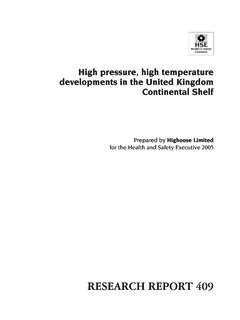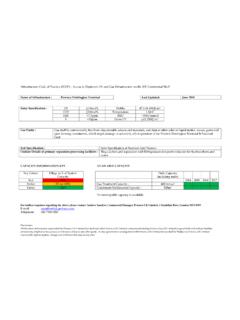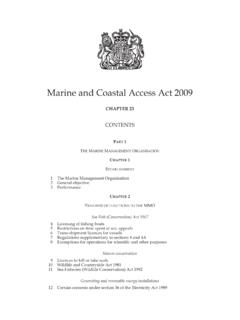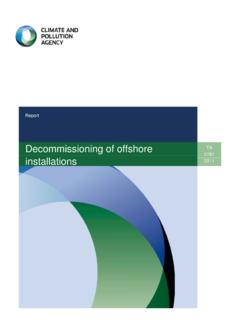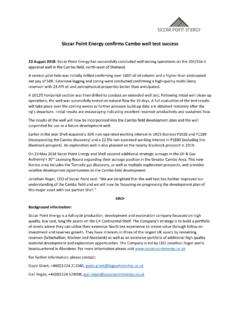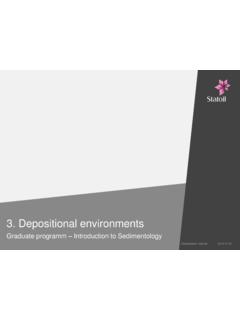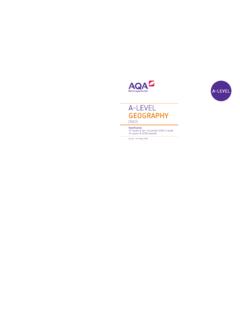Transcription of RR166 - An appraisal of existing seismic hazard estimates ...
1 HSE Health & Safety Executive An appraisal of existing seismic hazard estimates for the UK continental shelf Prepared by The Mallard Partnership for the Health and Safety Executive 2003 RESEARCH REPORT 166 HSE Health & Safety Executive An appraisal of existing seismic hazard estimates for the UK continental shelf Mallard (Eng) Skipp FGS & Aspinall FGS The Mallard Partnership 26 Gloucester Street Winchcombe GLS4 5LX The first seismic hazard estimates for the UKCS were made for HSE in 1986, with later assessments being made in 1993 and the work on the most recent of these studies was completed, a draft ISO standard and a NORSOK standard have been published. Also, a medium-sized earthquake has occurred in the central North Sea, in an area previously considered to have low seismic activity. In this report, the most recent estimates (given in report OTO 2002/005) are synthesized with those from the earlier studies, using a specially-designed rating scheme, to generate hybrid contour maps of the peak ground acceleration (pga) hazard .
2 The reliability of these hybrid results is assessed by comparison with provisional, newly-calculated, de-minimis hazard figures based on catalogue completeness considerations. Until such time as a uniformly-derived hazard map is developed it is recommended that the 10-4 of exceedance pga hazard figure at any point in the offshore UKCS east of longitude 10 W should be taken to be highest of the figures given by: the new map of allowable minimal hazard levels, the new synthesized hazard map, and the estimate given by report OTO 2002/005. As there is no current information on hazard exposure at the lower frequencies that are of concern when designing offshore installations, recommendations are made as to how such estimates could be calculated. The characterization of ground motion is discussed, noting the significance of the differences between hard and soft sites and current thinking on vertical motion.
3 Attention is drawn to policy and technical issues that remain unresolved and suggestions made as to how those issues could be addressed. This report and the work it describes were funded by the Health and Safety Executive (HSE). Its contents, including any opinions and/or conclusions expressed, are those of the authors alone and do not necessarily reflect HSE policy. HSE BOOKS Crown copyright 2003 First published 2003 ISBN 0 7176 2778 0 All rights reserved. No part of this publication may be reproduced, stored in a retrieval system, or transmitted in any form or by any means (electronic, mechanical, photocopying, recording or otherwise) without the prior written permission of the copyright owner. Applications for reproduction should be made in writing to: Licensing Division, Her Majesty's Stationery Office, St Clements House, 2-16 Colegate.
4 Norwich NR3 1BQ or by e-mail to ii CONTENTS Executive summar y v 1 INTRODUCTION 1 Background and objectives 1 Scope 3 Approach adopted for conducting this appraisal 4 Structure of this report 6 2 GENERIC ISSUES RAISED BY THE REPORTS CONSIDERED IN THIS appraisal 8 3 SOME FUNDAMENTAL ASPECTS OF THE PRACTICE OF seismic hazard ASSESSMENT 11 General matters 11 Modelling seismicity 13 The value of hazard maps at low probabilities 17 The role of geological information 20 The effects on hazard levels of varying model parameter values 21 Concluding remarks 22 4 SYNTHESIS OF PGA hazard MAPS 23 The existing hazard maps 23 Making a synthesis of the existing hazard maps 27 Discussion 33 5 CHARACTERISING EARTHQUAKE GROUND MOTION FOR THE UKCS 42 Introduction 42 The ground motion characterisations proposed in the existing reports 44 The adequacy of the ground motion characterisations proposed in the existing reports 45 Time histories 52 6 VERTICAL MOTION 54 7 TOWARDS ESTIMATING THE 1HZ hazard ACROSS THE UKCS 56 8 CONCLUDING REMARKS AND RECOMMENDATIONS 58 The ground motion hazard in terms of pga 58 9 REFERENCES 66 The reports forming the input to this appraisal 66 References quoted in main text 66 References quoted in appendices 68 A brief selected bibliography 68 iii
5 10 Appendix 1: Notes on the individual Reports 71 Report 1 Principia Mechanica Ltd. (1986) Report 2 BGS & Ove Arup and Partners (1997) Report 3 NORSAR & NGI (1998) Report 4 EQE International Ltd. (2002) 71 72 74 77 11 Appendix 2: Attenuation Relationships 80 Report 1 Principia Mechanica Ltd. (1986) 80 Report 2 BGS and Ove Arup & Partners (1997) 80 Report 3 NORSAR & NGI (1988) 81 Report 4 EQE International Ltd. (2002) 83 Figures Following page 83: Figure 1 Report 1: replicated 10-2 pga contours Figure 2 Report 1: replicated 10-4 pga contours Figure 3a Report 2: replicated 10-2 pga contours (east of 10 W) Figure 3b Report 2: replicated 10-2 pga contours (west of 1 W) Figure 4a Report 2: replicated 10-4 pga contours (east of 10 W) Figure 4b Report 2: replicated 10-4 pga contours (west of 1 W) Figure 5 Report 4: replicated 10-2 pga contours (east of 10 W) Figure 6 Report 4.
6 Replicated 10-4 pga contours (east of 10 W) Figure 7 UK continental shelf Designations [2001] showing areas covered by existing reports Figure 8 Hybrid 10-2 pga hazard contour map (east of 10 W) Figure 9 Hybrid 10-4 pga hazard contour map (east of 10 W) Figure 10 Hybrid 10-4 pga hazard contour map compared with onland site-specific hazard estimates Figure 11 Macroseismic earthquake magnitude completeness thresholds in and around the British Isles Figure 12 Minimal 10-4 pga hazard contour map determined from catalogue completeness considerations Figure 13 Difference contours for hazards indicated by Figure 9 and Figure 12 Figure 14 Combination 10-4 pga hazard contour map (the hazard levels plotted are the higher of those indicated at each point by Figure 9, or by Figure 12) Figure 15 Comparison of PML [1981] spectral shapes for hard and soft sites Figure 16 Comparison of various spectral shapes for bedrock/hard sites Figure 17 Comparison of various spectral shapes for soft sites Figure 18 Difference contours for hazards indicated by Figure 14 and Figure 6 ( Figure 14 minus Figure 6) Figure 19 Recommended 10-4 pga hazard contour map (the hazard levels plotted are the higher of those indicated at each point by Figure 14 or by Figure 6) iv Executive summary The first seismic hazard estimates for the offshore UK continental shelf (UKCS) were made for HSE in 1986, with later subsequent studies being published in 1993 and 2002.
7 Since the work on the most recent of these studies was completed, a number of developments have taken place. Two design standards for offshore structures have been published (a draft ISO standard and a NORSOK standard), and a medium-sized ( ) earthquake has occurred in the central North Sea, in an area previously thought to be characterised by low seismic activity. With this background, the Offshore Safety Division of the Health and Safety Executive (HSE OSD) commissioned The Mallard Partnership to carry out an evaluation of several existing hazard studies ( not only the most recent report, but also some of the earlier work) in the light of recent methodological advances. HSE OSD also wished to be informed about such future work as might be necessary to address any issues revealed by this appraisal that cannot be resolved using available information.
8 As part of the exercise, comparisons were to be made with the requirements of various design standards, including the new draft ISO standard. The existing reports made available by HSE OSD for this appraisal are: Principia Mechanica Ltd. (1986) 'North Sea seismicity'. UK Dept. of Energy Offshore Technology Report No. OTH 86 219, HMSO, London. BGS & Ove Arup and Partners (1997) 'UK continental shelf seismic hazard '. Health and Safety Executive Offshore Technology Report OTH 93 416, HMSO, London. NORSAR & NGI (1998) ' seismic zonation for Norway'. Report for the Norwegian Council for Building Standardization. EQE International Ltd. (2002) ' seismic hazard UK continental shelf . Health and Safety Executive Offshore Technology Report 2002/005. The seismic hazard results provided by each of these studies, which are presented solely in the form of peak ground acceleration contour maps for certain annual probabilities of exceedance, and for various differing parts of the UKCS area, are taken and re-plotted to a uniform format for direct comparison and appraisal .
9 The strengths and weaknesses of the individual reports are discussed in depth, and a specially-devised scheme is used to weight their various results impartially, according to their respective merits. The results are then combined to generate a set of hybrid seismic hazard maps, representing an appropriate amalgamation of the information that is provided by the four separate studies. For seismic hazard at the 10-4 probability of exceedance, the hybrid contour map of offshore peak horizontal ground acceleration (pga) is compared with corresponding pga hazard levels determined in site-specific studies at a number of coastal sites around Britain. The reliability of the 10-4 probability of exceedance pga hybrid contour map is assessed by comparison with a provisional map of minimal pga hazard levels, determined independently, and specifically for this appraisal , from generic catalogue completeness v considerations.
10 Difference contours between this minimal hazard map and the levels of hazard indicated by the hybrid map are plotted to illustrate variations across the expanse of offshore waters around the British Isles. The two maps are then combined to form a newly derived 10-4 pga hazard contour map for areas of the offshore UKCS east of longitude 10 W (the hazard levels plotted being the higher of those indicated at each point on either map). The spatial differences between the hazard levels indicated by this combination map and by the results in the most recent of the existing reports (EQE International Ltd., 2002) are then explored. Whilst these differences are modest, and explicable, there are indications of systematic divergences in different parts of the UKCS area.










